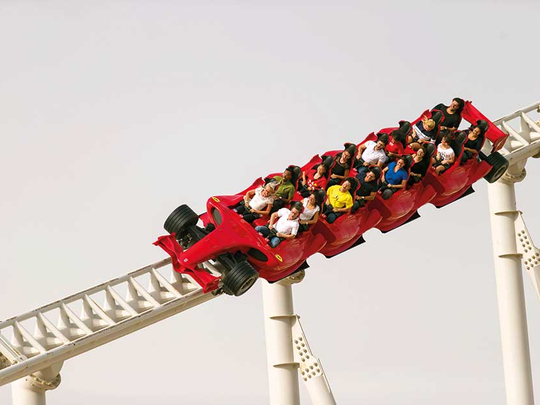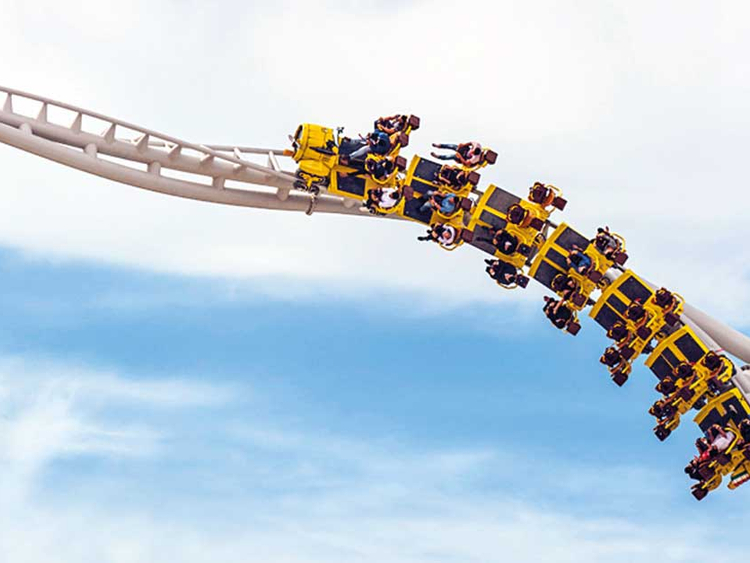
Abu Dhabi: It’s a weekday at Ferrari World Abu Dhabi, and a young German family has just stepped off Formula Rossa, the world’s fastest roller coaster. They’re hysterical. Mother, father, two young boys and a girl, all line up, hearts racing, faces red, panting like they’ve just finished a 100 metre sprint.
“We love roller coasters,” the dad says. “All of us.” The children are smiling from ear to ear, having just been hurtled through the sky at 240km/h on a plastic chair. Moments later, a man from Switzerland emerges from the back row of the ride. “My wife is waiting for me over there,” he says. “I couldn’t get her to go on the ride. Impossible.”
People from all the over world travel to ride the most famous roller coasters, to be rattled to their cores, to submit their bodies to self-inflicted fear. Others stand back and watch in awe, as a collection of strangers scream and laugh in beautiful harmony, as they loop, twist, and spin. It’s a phenomenon that’s lasted more than a century, and to this day, roller coasters remain the major attraction for any theme park around the world.
Baffling paradox
The word fear carries such negative connotations. Fear is daunting – fear is uncertain. Yet, more than a third of those that claimed to love roller coasters in recent interviews held at Ferrari World Abu Dhabi said they were ‘terrified’ at the time of riding. It’s a paradox that’s as baffling as it is interesting.
So why do we love to frighten ourselves at great heights and speeds, when we could just as easily be calmly settled on the sofa?
It turns out, according to psychologist Margee Kerr, that activating the feeling of fear is something humans desire, in the same way they desire happiness. Incredibly, the euphoria felt during a moment of fear is akin to the euphoria felt by total cheerfulness. This is because the adrenalin of a roller coaster activates our fight or flight response, which immediately suspends our rational mind, and prepares us for something that requires great attention in order to survive. In this state, we are gifted enough energy to see ourselves through the initial fear or threat, and our sensitivity to pain is significantly reduced.
The resulting sensation leaves us in a feeling of total bliss. An environment of controlled fear is essentially pure energy, and not much else. The key factor is the context in which it’s felt. Triggering the fight or flight response in a controlled environment will allow us to enjoy that rush of pure energy and absence from rational thought, while deep-down knowing that we are safe. It’s a simulator for pure adrenalin – and roller coasters are built to trigger just that.
Processing the fearful information during a roller coaster ride can be so intense on your emotional core, it’s instantly stored in your Hippocampus (the bit of your brain that looks after emotional memories) – once we understand we are threat-free and actually enjoyed that experience, the lust for loops stays with us forever. This is why when you’re riding Flying Aces you can almost hear screams of terror and gurgles of laughter simultaneously.
“Controlled adrenalin is such a release on the body. That feeling of pure joy and freedom that only a great roller coaster can give you is such a brilliant thing. We’ve worked with some of the world’s best designers to ensure these unique roller coasters offer guests the best possible experience time and time again,” says Jesse Vargas, general manager of Ferrari World Abu Dhabi.
“It’s telling that more than half of our park guests that have experienced our unique, hair-raising thrill rides claimed their personal or professional lives are ‘high-pressure’ or ‘busy’.












